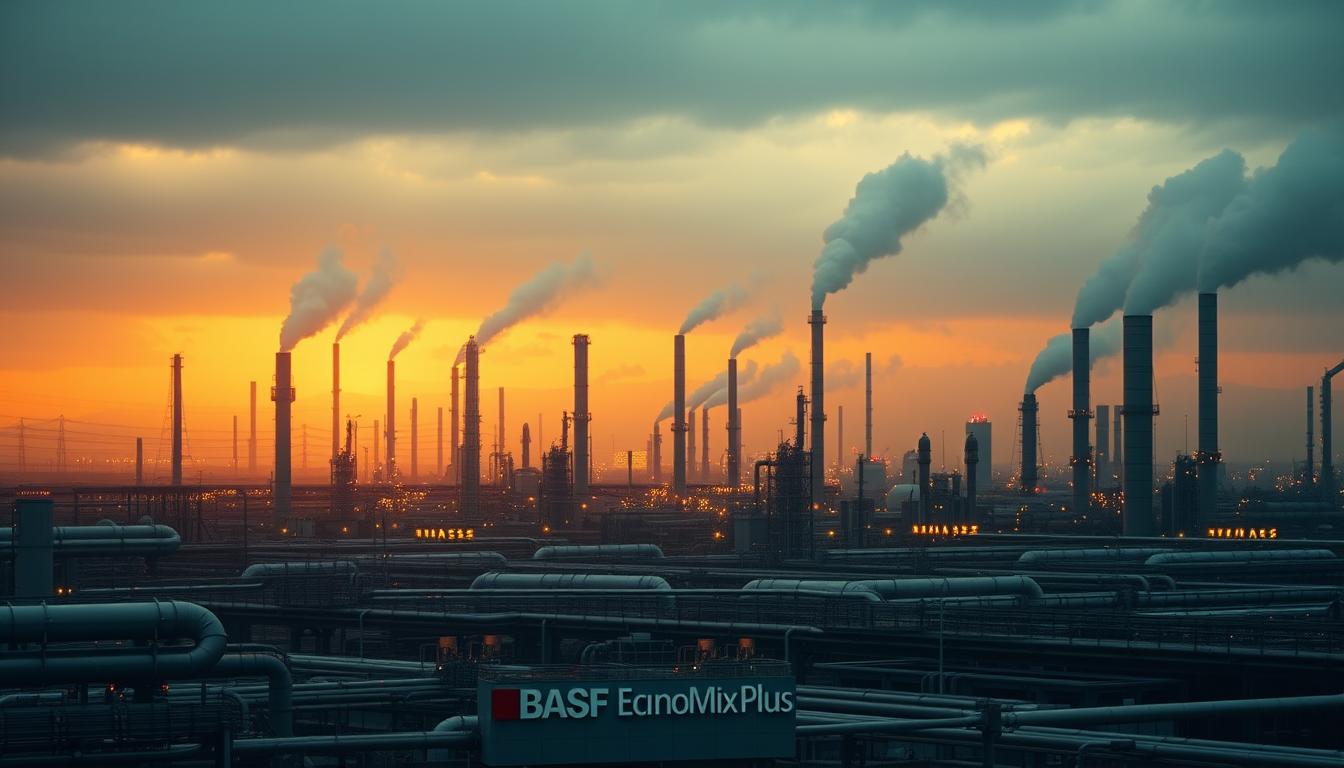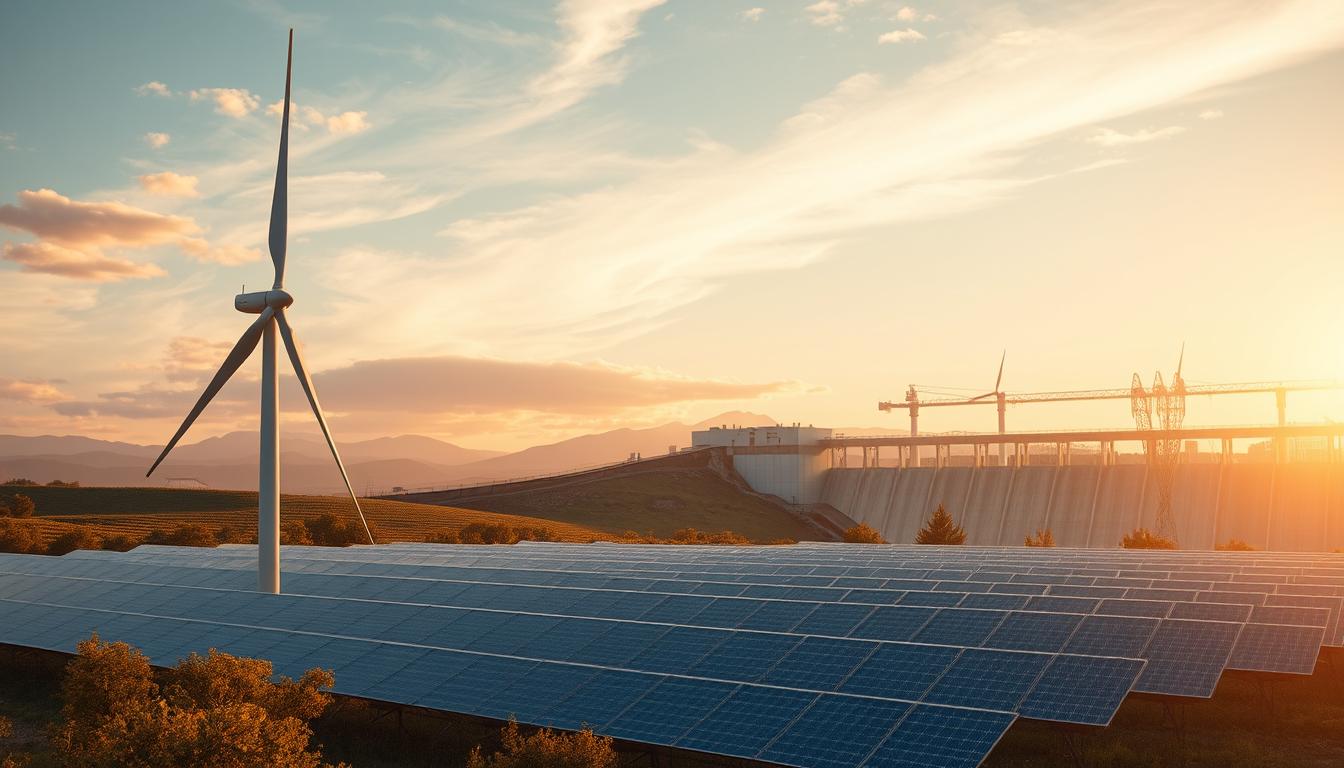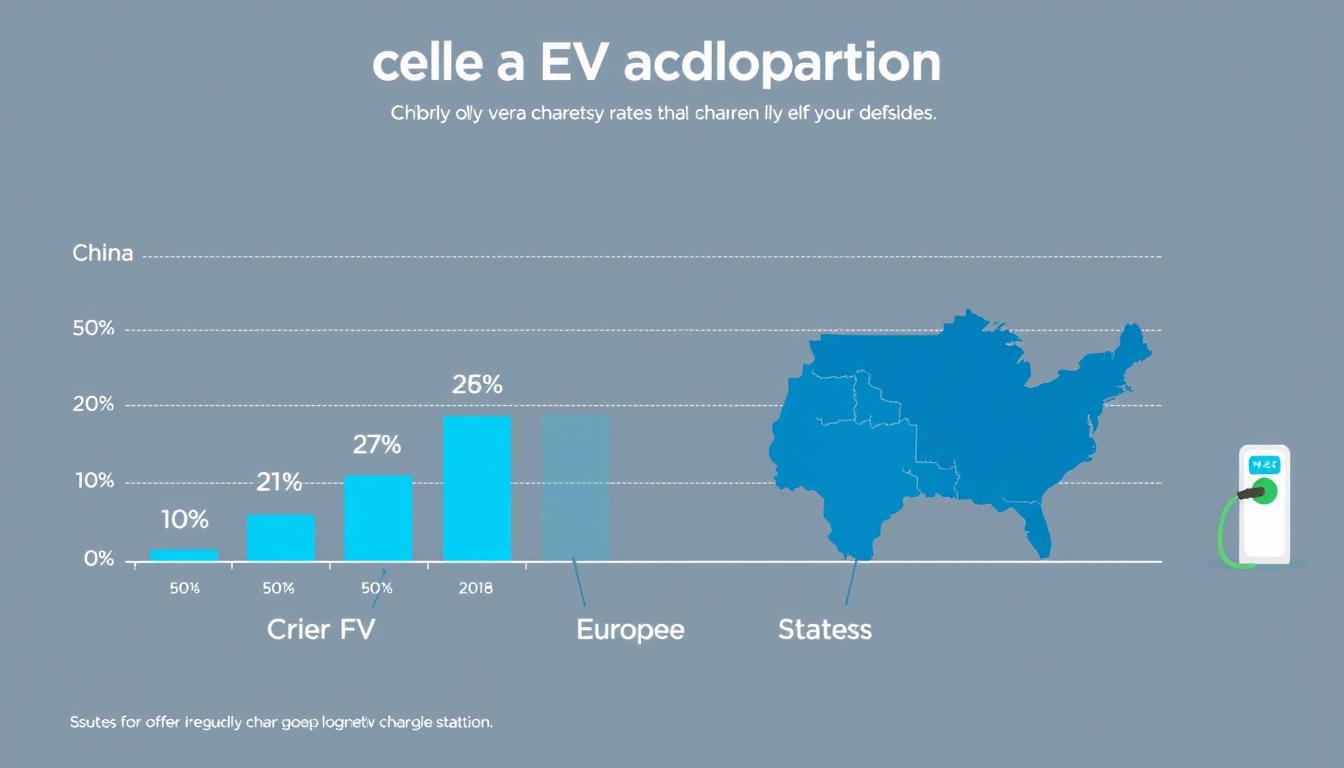As the world grapples with the challenges of climate change and reducing carbon emissions, companies like BASF are taking bold steps towards a more sustainable future. With a commitment to achieving net-zero emissions by 2050, BASF is investing heavily in clean energy technologies to reduce its environmental footprint.
The chemical industry is a significant contributor to greenhouse gas emissions, making it crucial for companies like BASF to adopt innovative production technologies and energy-efficient practices. By doing so, BASF aims to reduce its emissions by 25% by 2030 compared to 2018 levels.
Key Takeaways
- BASF is committed to achieving net-zero emissions by 2050.
- The company aims to reduce greenhouse gas emissions by 25% by 2030.
- Investments in clean energy technologies are crucial for reducing environmental impact.
- Innovative production technologies and energy-efficient practices are being adopted.
- BASF’s efforts are significant for global sustainability efforts in the chemical industry.
BASF’s Climate Neutrality Vision and Strategy
Driven by a steadfast dedication to climate protection, BASF is charting a course towards a more sustainable future. The company’s climate neutrality vision is comprehensive, extending beyond regulatory requirements to set ambitious targets that exceed the European Union’s emissions reduction goals.
Setting Ambitious Climate Targets
BASF has developed a climate strategy built on a dual approach: optimizing existing operations for immediate emissions reductions while developing breakthrough technologies for the long-term transformation of chemical production processes. The company’s 2030 emissions goal represents a reduction of approximately 60 percent compared to 1990 levels, surpassing the EU’s target of minus 55 percent. In 2018, BASF Group’s worldwide emissions amounted to 21.9 million metric tons of CO2 equivalents, roughly half of the 1990 figure.
| Year | CO2 Emissions (Million Metric Tons) | Reduction Percentage |
|---|---|---|
| 1990 | 43.8 | 0% |
| 2018 | 21.9 | 50% |
| 2030 (Target) | 17.52 | 60% |
The Net Zero Accelerator Unit
The Net Zero Accelerator unit serves as the driving force behind BASF’s climate strategy implementation, focusing on accelerating cross-divisional projects that significantly reduce greenhouse gas emissions across the company’s global operations. Under the leadership of Chairman of the Board of Executive Directors Dr. Martin Brudermüller, BASF has integrated climate protection as a central component of its corporate strategy, recognizing it as both a business imperative and ethical responsibility.
BASF’s climate targets are anchored in the company’s steering and compensation systems as a key performance indicator, giving climate protection significant weight in strategic decision-making processes. The company’s climate strategy includes transparent reporting on progress through frameworks like the Task Force on Climate-related Financial Disclosures (TCFD) and participation in CDP’s climate change questionnaire.
Why BASF Heavily Invests in Clean Energy Technologies
BASF’s significant investments in clean energy technologies are driven by a robust business case that aligns environmental sustainability with economic viability. The company’s commitment to reducing CO2 emissions and those upstream in the value chain contributes to its customers’ climate protection targets. By determining the Product Carbon Footprint for around 45,000 sales products, BASF creates transparency that helps target CO2 reduction measures to areas with the greatest potential impact and value creation.
Business Case for Sustainability Transformation
The business case for BASF’s sustainability transformation is built on the premise that reducing carbon footprints throughout the value chain creates significant business opportunities. By offering products with lower environmental impacts, BASF caters to increasingly sustainability-conscious customers. The company’s sustainability transformation strategy focuses on both reducing its own operational emissions and developing innovative solutions that help customers across industries reduce their environmental footprints.
- Aligns environmental responsibility with long-term economic viability and market competitiveness.
- Recognizes that reducing carbon footprints creates significant business opportunities.
- Creates transparency through Product Carbon Footprints for approximately 45,000 sales products.
Competitive Advantage Through Carbon Footprint Reduction
By reducing its carbon footprint, BASF positions itself as an industry leader in sustainability transformation, creating competitive advantages as regulatory frameworks, customer expectations, and market demands increasingly favor low-carbon products and processes. “Investing in clean energy technologies is not just about reducing emissions; it’s about creating a sustainable business model that thrives in a low-carbon economy,” reflecting BASF’s forward-thinking approach.
The company’s approach demonstrates how major industrial companies can turn climate challenges into business opportunities by investing in technologies that simultaneously reduce emissions and create new value propositions in the marketplace. With a strong focus on energy efficiency and reducing greenhouse gas emissions, BASF is committed to making its production processes more sustainable.
BASF’s Current Emissions Profile and Reduction Goals
As part of its sustainability efforts, BASF has detailed its emissions profile and plans for reduction. The company’s emissions profile encompasses three key categories: Scope 1 (direct greenhouse gas emissions from production processes), Scope 2 (indirect emissions from electricity purchases from renewable sources), and Scope 3.1 (emissions related to raw materials procurement and use of products).

Reducing Scope 1 and 2 Emissions
BASF has established a clear target to reduce Scope 1 and 2 greenhouse gas emissions by 25% by 2030 compared to the 2018 baseline. This translates to a decrease from 21.9 million metric tons to 16.4 million metric tons, despite planned business growth and the construction of a new Verbund site in Southern China. In 2023, the company’s emissions from production and energy purchases amounted to 16.9 million metric tons of CO2 equivalents, showing progress toward the 2030 target compared to 18.4 million metric tons in 2022.
The company’s strategy to achieve this reduction includes increasing renewable energy use and implementing CO2 abatement technologies. By advancing these initiatives, BASF aims to minimize its environmental footprint while continuing to grow its business.
Addressing Scope 3.1 Emissions
For Scope 3.1 emissions, BASF has set a target to reduce specific raw materials-related emissions by 15% by 2030 from the 2022 baseline. This effort addresses the significant upstream impact in their value chain. The company is working closely with its suppliers through programs like the Supplier CO2 Management Program to achieve this goal.
By extending its long-term net-zero greenhouse gas emissions target by 2050 to include not only Scope 1 and 2 but also Scope 3.1 emissions, BASF demonstrates a comprehensive approach to emissions reduction. This commitment underscores the company’s dedication to sustainability and reducing its environmental impact.
Renewable Energy Investments and Partnerships
To support its growing electricity needs, BASF is pursuing a comprehensive renewable energy strategy that aims to significantly reduce greenhouse gas emissions. This involves significant investments in both owned assets and long-term supply agreements to support its ambitious climate goals, particularly in utilizing renewable sources.
The company’s electricity consumption is expected to increase due to the planned gradual electrification of its steam cracker generation and the switch from natural gas-based to electricity-based, low-emission production processes, aligning with the board executive directors’ vision for sustainable practices.

Hollandse Kust Zuid Offshore Wind Farm Project
BASF’s commitment to renewable energy is exemplified by its participation in the Hollandse Kust Zuid offshore wind farm project. Developed in partnership with Vattenfall and Allianz, this project is one of the largest offshore wind farms globally, with 139 turbines and a capacity of 1.5 gigawatts.
The wind farm was officially inaugurated in fall 2023 and is expected to be fully operational by 2024. This project represents a significant step towards BASF’s goal of sourcing more than 60% of its power needs from renewable sources by 2030.
Strategic Partnerships with Energy Providers
BASF has formed strategic partnerships with energy providers to secure its renewable energy supply. The company has signed a memorandum of understanding with Vattenfall for a shareholding in the Nordlicht 1 and 2 wind farms, which will have a total capacity of 1.6 gigawatts upon completion in 2028. These partnerships are crucial for BASF to achieve its climate neutrality vision and reduce its reliance on non-renewable energy sources.
Regional Renewable Energy Initiatives in Asia and North America
In Asia, BASF has established a joint venture with Mingyang for a 500-megawatt offshore wind farm in Southern China, aimed at supplying the Zhanjiang Verbund site with renewable electricity. Additionally, the company has extended its long-term contract with the State Power Investment Corporation for 1,000 gigawatt hours of green electricity annually from 2025.
In North America, BASF has secured approximately 250 megawatts of solar generation capacity through virtual power purchase agreements, along with contracts with X-ELIO for 48 megawatts of solar power and EDF Energy Services for 35 megawatts of wind energy.
By diversifying its renewable energy portfolio through these investments and partnerships, BASF is well on its way to achieving its climate goals and reducing its carbon footprint. The company’s focus on electricity from renewable sources is a key component of its overall sustainability strategy.
The Verbund System: BASF’s Approach to Energy Efficiency
The Verbund system represents a highly innovative approach to energy management at BASF. It is designed to optimize energy efficiency by integrating production plants and creating synergies that significantly reduce energy consumption and emissions.
Integration of Production Plants for Resource Efficiency
The Verbund system allows BASF to manage value chains in a resource-efficient manner. For instance, waste heat from one plant’s production process is utilized as energy input for other plants. This approach not only reduces energy consumption but also minimizes greenhouse gas emissions, including CO2 emissions. In 2023, the Verbund system saved approximately 17.3 million MWh of electricity renewable energy, preventing 3.5 million metric tons of greenhouse gas emissions.

Combined Heat and Power Generation
BASF generates steam and power primarily using natural gas (78.8%) and substitute fuels (17.8%). The company’s highly efficient combined heat and power plants provided 51% of BASF’s electricity demand in 2023. These plants use gas and steam turbines, significantly reducing the carbon footprint of energy production. Compared to separate methods of generating steam and electricity, BASF’s combined heat and power generation saved 10.8 million MWh of fossil fuels and avoided 2.2 million metric tons of CO2 emissions in 2023.
As BASF continues to invest in creating and optimizing Verbund structures, the company is recognizing the system as a key component of its carbon-optimized energy supply strategy. By leveraging the Verbund system, BASF is able to reduce its reliance on external energy sources and minimize its environmental impact.
“The Verbund system is a critical element in our efforts to achieve climate neutrality by 2050,” reflecting BASF’s commitment to sustainable energy practices.
Developing Low-Emission Production Processes
BASF is at the forefront of developing low-emission production processes, a crucial step towards achieving climate neutrality. As Dr. Martin Brudermüller, Chairman of the Board of Executive Directors at BASF, notes, “The path leading to the energy transition is a huge challenge for the energy-intensive chemical sector in particular.”
The company’s sustainability strategy is centered on climate protection, and reducing greenhouse gas emissions is a top priority. BASF has already made significant strides in optimizing energy generation and production processes, resulting in substantial CO2 emissions reductions.
Electrification of Steam Crackers
One of BASF’s most significant innovations is the electrification of steam crackers. In collaboration with SABIC and Linde, BASF is working on a pilot furnace for the world’s first electrically heated steam cracker, which could enable nearly CO2-free production of basic chemicals. This technology has the potential to significantly reduce emissions from the production of fundamental chemicals.
Carbon Capture and Storage Projects
BASF is also investing in carbon capture and storage (CCS) projects as part of its emissions reduction strategy. The company plans to invest in one of the largest CCS projects under the North Sea at the Antwerp site, potentially avoiding more than 1 million metric tons of CO2 emissions annually.
Waste Heat Recovery Technologies
Waste heat recovery technologies are being implemented across BASF’s operations to further reduce emissions. The company is developing systems to produce CO2-free steam from waste heat using electrical heat pumps in collaboration with Siemens Energy. This innovative approach will help minimize the carbon footprint of BASF’s production processes.
The transformation to low-emission production processes will significantly increase BASF’s electricity demand. Projections indicate that by 2035, the group’s electricity requirements could be more than three times higher than current levels. This shift underscores the importance of renewable energy sources in powering BASF’s future operations.
Hydrogen Production Technologies
BASF is at the forefront of developing innovative hydrogen production technologies. Hydrogen is a critical raw material for the chemical industry and is expected to play a significant role in the future as a potential energy carrier. As part of its clean energy strategy, BASF is exploring alternative methods to produce hydrogen with reduced CO2 emissions.
Methane Pyrolysis for CO2-Free Hydrogen
BASF is testing methane pyrolysis, a virtually emission-free process for hydrogen production, at its Ludwigshafen site in Germany. This process requires considerably less electricity compared to other methods like water electrolysis, especially when powered by renewable energy. The successful testing of a new reactor concept at the pilot plant in 2021 marked a significant technical milestone, paving the way for further scaling of this technology.
PEM Water Electrolysis Projects
In partnership with Siemens Energy, BASF has commenced construction of a 54-megawatt PEM water electrolyzer at the Ludwigshafen site. Scheduled to begin operation in 2025, this project will produce up to 8,000 metric tons of emission-free hydrogen annually, utilizing electricity from renewable sources. This is expected to reduce greenhouse gas emissions at the site by approximately 72,000 metric tons per year.
The development of these hydrogen production technologies underscores BASF’s commitment to reducing its carbon footprint and achieving climate neutrality. By leveraging renewable energy and innovative production methods, BASF is poised to play a leading role in the transition to a more sustainable energy landscape.
Financial Commitment to Clean Energy Transition
BASF’s journey towards climate neutrality involves significant financial planning and investment. The company has made substantial commitments to reduce its carbon footprint and achieve its climate targets.
Investment Plans Through 2030
BASF plans to invest up to €1 billion by 2025 and an additional €2-3 billion by 2030 to support its clean energy transition. According to Dr. Martin Brudermüller, Chairman of the Board of Executive Directors, “The new climate goals underscore our determination and BASF’s commitment to the Paris Climate Agreement.” This investment will be crucial in driving the development and deployment of new CO2-free processes for chemical production.
The company’s investment strategy prioritizes increasing the use of renewable energies and accelerating the development of low-emission technologies. This approach is expected to reduce the company’s carbon footprint significantly.
Economic Challenges and Funding Strategies
Despite the significant investments, BASF faces economic challenges in its transition to clean energy. Most new technologies are not yet competitive under current market conditions, creating a need for collaboration between industry, policymakers, and consumers. To address this, BASF is pursuing funding from European and national programs such as Important Projects of Common European Interest (IPCEI) to support its capital-intensive transitions.
The company’s commitment to reducing its CO2 emissions by millions of tons is a key aspect of its climate strategy. By investing in clean energy technologies and improving energy efficiency, BASF aims to achieve its climate targets and contribute to a more sustainable future.
Regulatory Framework and Industry Collaboration
The success of BASF’s energy transition relies on a combination of supportive policies and collaborative efforts. As the company strives for climate neutrality by 2050, it recognizes the need for a conducive regulatory environment that fosters innovation and investment in clean energy technologies.
Policy Support Needed for Energy Transition
A critical precondition for transforming chemical production is the reliable availability of large quantities of renewable electricity at competitive prices. Chairman Brudermüller emphasizes that “regulatory framework conditions are also essential for making this transformation economically feasible.” BASF is actively engaging with policymakers to shape regulations that support the energy transition while preserving international competitiveness.
Partnerships with Industry and Research Institutions
BASF collaborates with industry partners on breakthrough technologies, such as electrically heated steam crackers for the production of basic chemicals. Research partnerships with academic and scientific institutions help accelerate innovation in areas like carbon capture, hydrogen production, and electrification of production processes. By working together, BASF aims to drive the development of climate-friendly processes and technologies.
As Brudermüller notes, “we need new cooperation between industry and policymakers that leads to positive, outcome-oriented regulations.” This collaborative approach is crucial for achieving the ambitious climate targets set by BASF and the broader chemical industry.
Conclusion: BASF’s Path to Climate Neutrality by 2050
As a leader in the chemical industry, BASF is pioneering the path to climate neutrality by 2050. This ambitious goal represents a significant transformation journey, combining short-term efficiency improvements with long-term technological innovation. BASF’s strategy integrates multiple approaches, including increasing renewable energy use, developing low-emission production processes, and implementing the Verbund system for energy efficiency.
The company’s commitment to reducing its carbon footprint is evident in its efforts to advance hydrogen technologies and reduce greenhouse gas emissions across the value chain. To learn more about BASF’s climate advocacy and efforts, you can review their Climate Advocacy Review. Success will depend on supportive regulatory frameworks, industry collaboration, and consumer acceptance of potentially higher-priced but lower-carbon products. BASF’s journey demonstrates how large industrial companies can address climate challenges while maintaining competitiveness through strategic planning and technological innovation.
By achieving climate neutrality, BASF is positioning itself to thrive in a future economy where carbon footprint reduction becomes increasingly valuable to customers, investors, and society.













